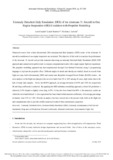JavaScript is disabled for your browser. Some features of this site may not work without it.
| dc.contributor.author | Casadei, Loris | |
| dc.contributor.author | Könözsy, László Z. | |
| dc.contributor.author | Lawson, Nicholas J. | |
| dc.date.accessioned | 2019-05-21T09:53:53Z | |
| dc.date.available | 2019-05-21T09:53:53Z | |
| dc.date.issued | 2019-05-15 | |
| dc.identifier.citation | Casadei L, Könözsy L, Lawson NJ. (2019) Unsteady Detached-Eddy Simulation (DES) of the Jetstream 31 aircraft in One Engine Inoperative (OEI) condition with propeller modelling. Aerospace Science and Technology, Volume 91, August 2019, pp. 287-300 | en_UK |
| dc.identifier.issn | 1270-9638 | |
| dc.identifier.uri | https://doi.org/10.1016/j.ast.2019.05.034 | |
| dc.identifier.uri | https://dspace.lib.cranfield.ac.uk/handle/1826/14187 | |
| dc.description.abstract | Numerical results from a three-dimensional (3D) computational fluid dynamics (CFD) model of the Jetstream 31 aircraft in conditions of one engine inoperative are presented. The objective of this work is to analyse the performance of the Jetstream 31 aircraft and provide transient data using an unsteady Detached-Eddy Simulation (DES) CFD approach and a numerical propeller model to compare computational results with a single engine flight test experiment. The propeller modelling approach has been implemented through User-Defined Functions using C programming language to replicate the propeller effect. Different angles of attack and sideslip are studied, based on records from flight test data, both with unsteady (DES) and steady-state Reynolds-Averaged Navier-Stokes (RANS) models. An error analysis on the flight test data provides an error band from 2% to 16% among all cases, high values due to the lack of many data samples. Across the RANS approach, an average deviation of 6.9% and 3.8% for respectively lift and drag coefficients is achieved. By applying the DES turbulence modelling approach, a better lift prediction is achieved (5.4%) despite a slightly worse drag (4.5%). It has also been found that 80% of the numerical results are within the error band defined. A close agreement has been found within moment coefficients, with average percentage deviations from 3.3% to 7.0%. Overall, an analysis has been carried out in the present work, both on the flight test and computational sides to provide reliable numerical results of these aerodynamic properties. | en_UK |
| dc.language.iso | en | en_UK |
| dc.publisher | Elksevier | en_UK |
| dc.rights | Attribution-NonCommercial-NoDerivatives 4.0 International | * |
| dc.rights.uri | http://creativecommons.org/licenses/by-nc-nd/4.0/ | * |
| dc.subject | Unsteady turbulent flows | en_UK |
| dc.subject | Detached-Eddy Simulation (DES) | en_UK |
| dc.subject | Unsteady aerodynamics | en_UK |
| dc.subject | Full aircraft simulation | en_UK |
| dc.subject | Drag and lift prediction | en_UK |
| dc.subject | Pressure and moment | en_UK |
| dc.subject | Experimental flight test | en_UK |
| dc.title | Unsteady Detached-Eddy Simulation (DES) of the Jetstream 31 aircraft in One Engine Inoperative (OEI) condition with propeller modelling | en_UK |
| dc.type | Article | en_UK |
| dc.identifier.cris | 23462213 |
Files in this item
The following license files are associated with this item:
This item appears in the following Collection(s)
-
Staff publications (SATM) [4367]

